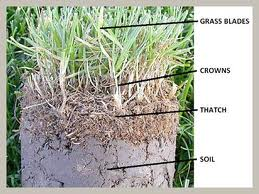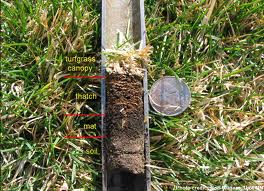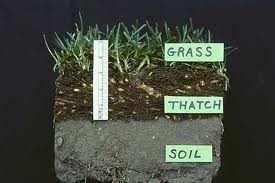Lawn thatch can be described as a tight and fibrous layer of living, dead and decaying organic matter primarily consisting of stems, crowns, and shoot growth of the grass. This layer develops above the soil surface and accumulates when the rate of shoot growth exceeds the rate at which the above ground parts of the plant decompose. When this takes place an excessive thatch layer begins to accumulate and become undesirable. More than ½” is typically considered excessive.

Contrary to common belief, lawn-thatch accumulation it is not the result of grass clippings left on the lawn. Grass clippings consist primarily of water which dry up, disintegrate, and decompose. Several factors including grass species, growth habit and poor management of cultural practices including over fertilization, poor watering and mowing techniques are the most common contributing factors.
Excessive lawn thatch accumulation is undesirable for many reasons. When left untreated, or unmanaged it can cause many problems including the following:
- It creates a perfect environment for increased insect and disease presence. Many turf insects live and feed in the thatch. Thatch also harbors disease causing organisms.
- Causes Localized Dry Spot (LDS). When thatch dries out it repels water.
- Makes turf very prone to mower scalping.
- Decreases heat, drought, and cold tolerance.
- Reduces the effectiveness of control products. Control products bind to the thatch and are not able to reach target areas.
- Reduces the movement of air, water and fertilizers.

If there is only a thin layer of thatch less than ½” it typically doesn’t create problems.
Common symptoms of excessive thatch include:
- Shallow roots
- Poor growth and turf colour
- Insect Infestation (Chinch bugs)
- Drought stress (even during irrigation)

Several cultural practices are recommended to help remove and manage excessive thatch accumulations including the following:
- Soil Core Aeration
- Organics Plus Topdressing
- Power Raking/Dethatching
- Polyon Fertilizer Applications
If you suspect that you have problems, but are unsure, contact your local Nutri-Lawn and we'll come out and take a look for you.







